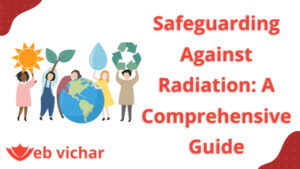Radiation, a form of energy present in various sources, poses potential risks to human health, ranging from the sun’s rays to electronic devices like cell phones and Wi-Fi routers. Protecting oneself from radiation becomes crucial, especially in scenarios where exposure is inevitable. In this comprehensive guide, we will explore how to safeguard against radiation in different situations.
Radiation from the Sun:
The sun’s rays are a common source of radiation. While sunlight is vital for our health, extended exposure to UV rays can lead to skin damage, sunburns, and skin cancer. Here are some tips to protect yourself from solar radiation:
- Wear protective clothing: Cover your skin with long-sleeved shirts, pants, and hats offering shade to your face and neck. Consider clothing with built-in UV protection.
- Use sunscreen: Apply sunscreen with an SPF of at least 30 to exposed skin, including face, ears, and neck. Reapply every two hours.
- Seek shade: Stay in the shade, particularly during peak sun hours from 10 am to 4 pm. Use umbrellas, tents, or shelters when outdoors.
Radiation from Electronic Devices:
Electronic devices emit low levels of radiation, which are generally considered safe. Nonetheless, it’s essential to protect yourself from prolonged exposure. Follow these tips:
- Keep devices at a distance: Maintain a distance between your body and electronic devices to minimize radiation exposure.
- Use a headset or speakerphone: Reduce radiation exposure to your head and brain by using a headset or speakerphone.
- Limit exposure: Take breaks from using electronic devices and avoid using them in bed.
Radiation from Medical Procedures:
Medical procedures like X-rays, CT scans, and radiation therapy use higher levels of radiation for diagnosis and treatment. While generally safe, prolonged exposure can be harmful. Here’s how to protect yourself:
- Discuss risks with your doctor: Before undergoing any procedure involving radiation, discuss risks and benefits with your doctor, ensuring a clear understanding.
- Follow safety protocols: Comply with safety protocols and instructions provided by medical staff, voicing concerns or questions if needed.
- Wear protective clothing: When undergoing radiation therapy, wear protective clothing as instructed by medical staff.
Radiation from Nuclear Disasters:
Nuclear disasters release substantial amounts of radiation into the environment, posing severe health risks. If affected, follow these steps:
- Follow evacuation orders: Comply with evacuation orders from authorities, and seek shelter in safe locations.
- Wear protective clothing: If entering a contaminated area, wear protective clothing, such as a hazmat suit.
- Limit exposure: Stay indoors, close windows and doors, and use HEPA filters to minimize radiation exposure.
- Avoid contaminated food and water: Consume only food and water from safe sources to prevent radioactive contamination.
Radiation from Natural Disasters:
Natural disasters like earthquakes and volcanic eruptions can release radiation, though usually at low levels. Protect yourself with these measures:
- Stay informed: Be aware of potential risks, follow instructions from authorities, and evacuate when necessary.
- Wear protective clothing: If entering a contaminated area, use protective clothing like a dust mask.
- Limit exposure: Stay indoors, close windows and doors, and use HEPA filters to reduce exposure to radioactive particles.
In conclusion, protecting yourself from radiation is essential for your health and well-being. Whether dealing with sun radiation, electronic devices, medical procedures, nuclear or natural disasters, taking appropriate measures is crucial. Follow the tips provided here and stay informed about potential risks. By doing so, you can reduce your radiation exposure and ensure your safety.


